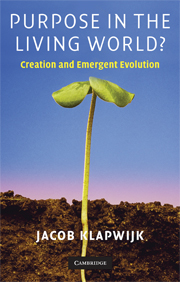Book contents
- Frontmatter
- Contents
- List of figures
- Preface
- Introduction
- 1 Does life on earth have a purpose?
- 2 Creationism, Intelligent Design, and Augustine's idea of time
- 3 Darwin, neo-Darwinism, and the naturalistic continuity claim
- 4 Miller's pre-biotic broth and the premises of evolutionism
- 5 A cold shudder along Darwin's back
- 6 The emergence theory of Morgan and Alexander
- 7 Luctor et emergo: what is emergent evolution?
- 8 Toward a general theory of emergent evolution
- 9 Hominization and the philosophy of mind
- 10 Augustinian faith and evolutionary science
- 11 The organism is a whole. The world is a habitat
- 12 The slumbering temptation of essentialism
- 13 Questions surrounding the emergence process
- 14 Enkapsis in nature. Is there an Omega point?
- Bibliography
- Index
7 - Luctor et emergo: what is emergent evolution?
Published online by Cambridge University Press: 05 June 2012
- Frontmatter
- Contents
- List of figures
- Preface
- Introduction
- 1 Does life on earth have a purpose?
- 2 Creationism, Intelligent Design, and Augustine's idea of time
- 3 Darwin, neo-Darwinism, and the naturalistic continuity claim
- 4 Miller's pre-biotic broth and the premises of evolutionism
- 5 A cold shudder along Darwin's back
- 6 The emergence theory of Morgan and Alexander
- 7 Luctor et emergo: what is emergent evolution?
- 8 Toward a general theory of emergent evolution
- 9 Hominization and the philosophy of mind
- 10 Augustinian faith and evolutionary science
- 11 The organism is a whole. The world is a habitat
- 12 The slumbering temptation of essentialism
- 13 Questions surrounding the emergence process
- 14 Enkapsis in nature. Is there an Omega point?
- Bibliography
- Index
Summary
Zeeland, a province in the southwest of The Netherlands, carries a beautiful motto on its coat of arms: Luctor et Emergo (I struggle and rise up). In its struggle with water – a challenge to the people of that province through the centuries – Zeeland's new reality has arisen: a world of islands with protective dikes, and fertile fields that have been wrestled from the sea. The motto shows that the people of Zeeland are open to what is new and unknown. Evolutionary biologists should be able to recognize the image. Luctor parallels the necessary struggle for survival of the species. Emergo mirrors the possibility, small though it may be, that in this struggle something entirely new may come to the fore: a higher form of being with new functional properties.
MOZART AND “TWINKLE, TWINKLE, LITTLE STAR”
Emergence is like a melody that comes into being at a concert. One sits in the auditorium, full of background noise. But when the conductor climbs the podium, noise gives way to applause, and then – silence. And in that silence the orchestra begins to play a melody. How do the listeners experience that melody? A physicist in the audience has one answer: for him or her the melody is a combination of air vibrations that cause sound waves which resonate in the eardrum. The physicist is right, but is that all? Is the melody not more than sympathetic vibrations of the eardrum?
- Type
- Chapter
- Information
- Purpose in the Living World?Creation and Emergent Evolution, pp. 103 - 138Publisher: Cambridge University PressPrint publication year: 2008

